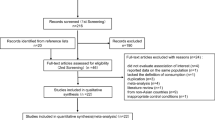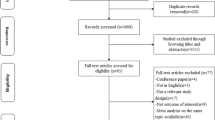Abstract
Objectives
To study the association between the intake of fruit and vegetables and risk of esophageal adenocarcinoma (EAC), we summarized the evidence from observational studies in categorical and linear dose–response meta-analyses.
Methods
Eligible studies published up to June 2013 were retrieved via computerized searches of MEDLINE and EMBASE. Random-effects models were used to calculate summary relative risks (SRRs) and the corresponding 95 % confidence intervals (CIs). Between-study heterogeneity was assessed using the Cochran’s Q and I 2 statistics.
Results
A total of 12 studies involving 1,572 cases of EAC were included in this meta-analysis. Based on the highest versus lowest analysis, inverse associations were observed between intakes of vegetable (SRRs = 0.76, 95 % CIs 0.59–0.96; P heterogeneity = 0.098, I 2 40.4 %; n = 9 studies), intakes of fruit (SRRs = 0.73, 95 % CIs, 0.55–0.98; P heterogeneity = 0.03, I 2 = 52.9 %; n = 9 studies), and intakes of total vegetables and fruit combined (SRRs = 0.68, 95 % CI 0.49–0.93; P heterogeneity = 0.162, I 2 = 38.9 %; n = 5 studies). Similar results were also observed in a linear dose–response analysis.
Conclusion
These data support the hypothesis that intakes of vegetables and fruit may significantly reduce the risk of EAC. Further investigation with prospective designs, validated questionnaires, and good control of important confounders is warranted.



Similar content being viewed by others
Abbreviations
- EC:
-
Esophageal cancer
- ESCC:
-
Esophageal squamous cell carcinoma
- EAC:
-
Esophageal adenocarcinoma
- BMI:
-
Body mass index
- FFQ:
-
Food frequency questionnaire
- SRR:
-
Summary relative risk
- CI:
-
Confidence interval
- GERD:
-
Gastroesophageal reflux disease
References
Thrift AP, Whiteman DC (2012) The incidence of esophageal adenocarcinoma continues to rise: analysis of period and birth cohort effects on recent trends. Ann Oncol 23:3155–3162
Ferlay J, Shin HR, Bray F, Forman D, Mathers C, Parkin DM (2010) Estimates of worldwide burden of cancer in 2008: GLOBOCAN 2008. Int J Cancer 127:2893–2917
Erichsen R, Robertson D, Farkas DK, Pedersen L, Pohl H, Baron JA et al (2012) Erosive reflux disease increases risk for esophageal adenocarcinoma, compared with nonerosive reflux. Clin Gastroenterol Hepatol 10(475–480):e471
Reid BJ, Li X, Galipeau PC, Vaughan TL (2010) Barrett’s oesophagus and oesophageal adenocarcinoma: time for a new synthesis. Nat Rev Cancer 10:87–101
Kubo A, Corley DA (2006) Body mass index and adenocarcinomas of the esophagus or gastric cardia: a systematic review and meta-analysis. Cancer Epidemiol Biomarkers Prev 15:872–878
Tramacere I, La Vecchia C, Negri E (2011) Tobacco smoking and esophageal and gastric cardia adenocarcinoma: a meta-analysis. Epidemiology 22:344–349
Mayne ST, Risch HA, Dubrow R, Chow WH, Gammon MD, Vaughan TL et al (2001) Nutrient intake and risk of subtypes of esophageal and gastric cancer. Cancer Epidemiol Biomarkers Prev 10:1055–1062
Murphy SJ, Anderson LA, Ferguson HR, Johnston BT, Watson PR, McGuigan J et al (2010) Dietary antioxidant and mineral intake in humans is associated with reduced risk of esophageal adenocarcinoma but not reflux esophagitis or Barrett’s esophagus. J Nutr 140:1757–1763
Coleman HG, Murray LJ, Hicks B, Bhat SK, Kubo A, Corley DA et al (2013) Dietary fiber and the risk of precancerous lesions and cancer of the esophagus: a systematic review and meta-analysis. Nutr Rev 71:474–482
Zhang ZF, Kurtz RC, Yu GP, Sun M, Gargon N, Karpeh M Jr et al (1997) Adenocarcinomas of the esophagus and gastric cardia: the role of diet. Nutr Cancer 27:298–309
Chen H, Ward MH, Graubard BI, Heineman EF, Markin RM, Potischman NA et al (2002) Dietary patterns and adenocarcinoma of the esophagus and distal stomach. Am J Clin Nutr 75:137–144
Gonzalez CA, Pera G, Agudo A, Bueno-de-Mesquita HB, Ceroti M, Boeing H et al (2006) Fruit and vegetable intake and the risk of stomach and oesophagus adenocarcinoma in the European Prospective Investigation into Cancer and Nutrition (EPIC-EURGAST). Int J Cancer 118:2559–2566
Anderson LA, Watson RG, Murphy SJ, Johnston BT, Comber H, Mc Guigan J et al (2007) Risk factors for Barrett’s oesophagus and oesophageal adenocarcinoma: results from the FINBAR study. World J Gastroenterol 13:1585–1594
Freedman ND, Park Y, Subar AF, Hollenbeck AR, Leitzmann MF, Schatzkin A et al (2007) Fruit and vegetable intake and esophageal cancer in a large prospective cohort study. Int J Cancer 121:2753–2760
Ibiebele TI, Hughes MC, Nagle CM, Bain CJ, Whiteman DC, Webb PM (2013) Dietary antioxidants and risk of Barrett’s esophagus and adenocarcinoma of the esophagus in an Australian population. Int J Cancer 133:214–224
Cheng KK, Sharp L, McKinney PA, Logan RF, Chilvers CE, Cook-Mozaffari P et al (2000) A case-control study of oesophageal adenocarcinoma in women: a preventable disease. Br J Cancer 83:127–132
Terry P, Lagergren J, Hansen H, Wolk A, Nyren O (2001) Fruit and vegetable consumption in the prevention of oesophageal and cardia cancers. Eur J Cancer Prev 10:365–369
Navarro Silvera SA, Mayne ST, Risch H, Gammon MD, Vaughan TL, Chow WH et al (2008) Food group intake and risk of subtypes of esophageal and gastric cancer. Int J Cancer 123:852–860
Pohl H, Wrobel K, Bojarski C, Voderholzer W, Sonnenberg A, Rosch T et al (2013) Risk factors in the development of esophageal adenocarcinoma. Am J Gastroenterol 108:200–207
Stewart BW, Kleihues P (2003) World cancer report. IARC Press, Lyon
Stroup DF, Berlin JA, Morton SC, Olkin I, Williamson GD, Rennie D et al (2000) Meta-analysis of observational studies in epidemiology: a proposal for reporting—Meta-analysis of Observational Studies in Epidemiology (MOOSE) group. JAMA 283:2008–2012
Riboli E, Norat T (2003) Epidemiologic evidence of the protective effect of fruit and vegetables on cancer risk. Am J Clin Nutr 78:559S–569S
Wells GA, Shea B, O’Connell D, Peterson J, Welch V, Losos M, Tugwell P (2000) The Newcastle-Ottawa Scale (NOS) for assessing the quality of nonrandomised studies in meta-analyses. http://www.ohri.ca/programs/clinical_epidemiology/oxford.asp. Accessed 15 June 2012
DerSimonian R, Laird N (1986) Meta-analysis in clinical trials. Control Clin Trials 7:177–188
Wolfgarten E, Rosendahl U, Nowroth T, Leers J, Metzger R, Holscher AH et al (2001) Coincidence of nutritional habits and esophageal cancer in Germany. Onkologie 24:546–551
Liu J, Wang J, Leng Y, Lv C (2013) Intake of fruit and vegetables and risk of esophageal squamous cell carcinoma: a meta-analysis of observational studies. Int J Cancer 133:473–485
Greenland S, Longnecker MP (1992) Methods for trend estimation from summarized dose–response data, with applications to meta-analysis. Am J Epidemiol 135:1301–1309
Orsini NBR, Greenland S (2006) Generalized least squares for trend estimation of summarized dose–response data. Stata J 6:40–57
Begg CB, Mazumdar M (1994) Operating characteristics of a rank correlation test for publication bias. Biometrics 50:1088–1101
Egger M, Davey Smith G, Schneider M, Minder C (1997) Bias in meta-analysis detected by a simple, graphical test. BMJ 315:629–634
Duval S, Tweedie R (2000) Trim and fill: a simple funnel-plot-based method of testing and adjusting for publication bias in meta-analysis. Biometrics 56:455–463
Rink SM, Mendola P, Mumford SL, Poudrier JK, Browne RW, Wactawski-Wende J et al (2013) Self-report of fruit and vegetable intake that meets the 5 a day recommendation is associated with reduced levels of oxidative stress biomarkers and increased levels of antioxidant defense in premenopausal women. J Acad Nutr Diet 113:776–785
Root MM, McGinn MC, Nieman DC, Henson DA, Heinz SA, Shanely RA et al (2012) Combined fruit and vegetable intake is correlated with improved inflammatory and oxidant status from a cross-sectional study in a community setting. Nutrients 4:29–41
Wilp J, Zwickenpflug W, Richter E (2002) Nitrosation of dietary myosmine as risk factor of human cancer. Food Chem Toxicol 40:1223–1228
Lukic M, Segec A, Segec I, Pinotic L, Pinotic K, Atalic B et al (2012) The impact of the vitamins A, C and E in the prevention of gastroesophageal reflux disease, Barrett’s oesophagus and oesophageal adenocarcinoma. Coll Antropol 36:867–872
Ibiebele TI, Hughes MC, Pandeya N, Zhao Z, Montgomery G, Hayward N et al (2011) High intake of folate from food sources is associated with reduced risk of esophageal cancer in an Australian population. J Nutr 141:274–283
Larsson SC, Giovannucci E, Wolk A (2006) Folate intake, MTHFR polymorphisms, and risk of esophageal, gastric, and pancreatic cancer: a meta-analysis. Gastroenterology 131:1271–1283
Steevens J, Schouten LJ, Goldbohm RA, van den Brandt PA (2011) Vegetables and fruits consumption and risk of esophageal and gastric cancer subtypes in the Netherlands Cohort Study. Int J Cancer 129:2681–2693
Prentice RL (2003) Dietary assessment and the reliability of nutritional epidemiology reports. Lancet 362:182–183
Willett WC, Sampson L, Stampfer MJ, Rosner B, Bain C, Witschi J et al (1985) Reproducibility and validity of a semiquantitative food frequency questionnaire. Am J Epidemiol 122:51–65
Rubenstein JH, Taylor JB (2010) Meta-analysis: the association of oesophageal adenocarcinoma with symptoms of gastro-oesophageal reflux. Aliment Pharmacol Ther 32:1222–1227
George SM, Park Y, Leitzmann MF, Freedman ND, Dowling EC, Reedy J et al (2009) Fruit and vegetable intake and risk of cancer: a prospective cohort study. Am J Clin Nutr 89:347–353
van Duijnhoven FJ, Bueno-De-Mesquita HB, Ferrari P, Jenab M, Boshuizen HC, Ros MM et al (2009) Fruit, vegetables, and colorectal cancer risk: the European Prospective Investigation into Cancer and Nutrition. Am J Clin Nutr 89:1441–1452
Willett WC, Howe GR, Kushi LH (1997) Adjustment for total energy intake in epidemiologic studies. Am J Clin Nutr 65:1220S–1228S discussion 1229S–1231S
Foschi R, Pelucchi C, Dal Maso L, Rossi M, Levi F, Talamini R et al (2010) Citrus fruit and cancer risk in a network of case–control studies. Cancer Causes Control 21:237–242
Bosetti C, Filomeno M, Riso P, Polesel J, Levi F, Talamini R et al (2012) Cruciferous vegetables and cancer risk in a network of case-control studies. Ann Oncol 23:2198–2203
Bobe G, Peterson JJ, Gridley G, Hyer M, Dwyer JT, Brown LM (2009) Flavonoid consumption and esophageal cancer among black and white men in the United States. Int J Cancer 125:1147–1154
Gonzalez CA, Jakszyn P, Pera G, Agudo A, Bingham S, Palli D et al (2006) Meat intake and risk of stomach and esophageal adenocarcinoma within the European Prospective Investigation into Cancer and Nutrition (EPIC). J Natl Cancer Inst 98:345–354
Acknowledgments
This work was supported by the National Natural Scientific Foundation of China (No. 81201780)and Science and Technology Commission of Shanghai Municipality medical guide foundation Research Grant (No. 114119a9300).
Conflict of interest
The authors disclose no conflicts of interests.
Author information
Authors and Affiliations
Corresponding author
Additional information
Bailing Li and Gengxi Jiang have contributed equally to this paper.
Electronic supplementary material
Below is the link to the electronic supplementary material.
Rights and permissions
About this article
Cite this article
Li, B., Jiang, G., Zhang, G. et al. Intake of vegetables and fruit and risk of esophageal adenocarcinoma: a meta-analysis of observational studies. Eur J Nutr 53, 1511–1521 (2014). https://doi.org/10.1007/s00394-014-0656-5
Received:
Accepted:
Published:
Issue Date:
DOI: https://doi.org/10.1007/s00394-014-0656-5




